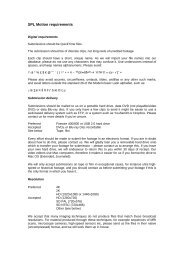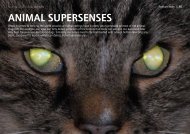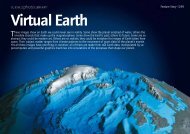THE WEIRD CLOUD ATLAS - Science Photo Library
THE WEIRD CLOUD ATLAS - Science Photo Library
THE WEIRD CLOUD ATLAS - Science Photo Library
Create successful ePaper yourself
Turn your PDF publications into a flip-book with our unique Google optimized e-Paper software.
<strong>THE</strong> <strong>WEIRD</strong> <strong>CLOUD</strong> <strong>ATLAS</strong><br />
It’s been a summer of clouds. Mainly dull and grey.<br />
But nature also produces clouds in all shapes, sizes<br />
and colours. Some can fool the unwary into thinking<br />
they’re having a UFO experience; others send<br />
folks rushing into storm shelters. Out of all the weird<br />
clouds in this set, though, the last one you’d want<br />
to see is the one created by humans: the distinctive<br />
cloud produced by an H-bomb.
<strong>Science</strong> <strong>Photo</strong> <strong>Library</strong> - Features<br />
Lenticular clouds – these spectacular clouds, so<br />
popular with UFO believers, are usually formed<br />
when air passes over mountain tops. Their strange<br />
stacked disc-like appearance gives them an eerie<br />
alien mothership look.<br />
Shelf clouds – seen from the ground, shelf clouds<br />
appear as low, wedge shaped clouds and are usually<br />
associated with severe thunderstorms.
<strong>Science</strong> <strong>Photo</strong> <strong>Library</strong> - Features<br />
Cumulonimbus seen from above – astronauts<br />
aboard the International Space Station snapped<br />
this cumulonimbus cloud. These clouds rise vertically<br />
until they hit a natural barrier, known as the<br />
tropopause, and flatten out, as seen in this image.<br />
Cumulonimbus usually herald the onset of a<br />
severe storm.<br />
Votices – The physics of waves determines how<br />
some clouds behave. These clouds look like they<br />
have had a hole punched through them. In fact<br />
they are naturally occurring vortices crafted by<br />
wind patterns on the clouds.
<strong>Science</strong> <strong>Photo</strong> <strong>Library</strong> - Features<br />
Noctilucent clouds are crystals of ice hanging<br />
around 80 kilometres high in the atmosphere that<br />
catch the light of the sun long after it has set on<br />
the horizon. Once a rare sight, these ‘night clouds’<br />
are on the increase, possibly a result of climate<br />
change.<br />
Supercells – these thunderstorms rotate with immense<br />
energy, causing a strong updraft and severe<br />
weather including tornadoes, hail, heavy rain,<br />
lightning and heavy winds. The huge, dark clouds<br />
produced by supercells look magnificent.
<strong>Science</strong> <strong>Photo</strong> <strong>Library</strong> - Features<br />
Gravity Clouds – these distinctive ripple-like clouds<br />
usually form over the ocean as buoyancy pushes<br />
air up and gravity pulls it back down causing a<br />
wave like effect.<br />
Mammatus clouds derive their name from the<br />
latin for mammary glands due to lobed hanging<br />
shape formed by these clouds. They can produce<br />
some dramatic and unusual patterns on the sky<br />
and are also associated with severe storms.
<strong>Science</strong> <strong>Photo</strong> <strong>Library</strong> - Features<br />
Jet stream cirrus clouds – the jet stream is that fast<br />
moving current of air that dictates how sunny or<br />
how wet our UK summers are.<br />
Pileus clouds are small clouds that form on top of a bigger<br />
cloud. In this photo, a pileus cloud (centre) has formed<br />
above a cloud of volcanic ash from the Sarychev volcano. The<br />
snap was taken by astronauts aboard the International Space<br />
Station.Note too the ring of non-cloudy air surrounding the<br />
volcano which is thought to have been caused by the eruption.
<strong>Science</strong> <strong>Photo</strong> <strong>Library</strong> - Features<br />
Sonic Boom Cloud<br />
This F/A-10 Hornet fighter jet is not flying through<br />
a cloud, instead, it created the cloud by accelerating<br />
towards the speed of sound (768mph). It is<br />
thought that the drop in air pressure around the<br />
plane when it travels so far causes moist air to condense<br />
and form water droplets.<br />
Actinoform Clouds<br />
Only visible from space, these large cloud formations<br />
form ray like patterns over hundreds of<br />
kilometres. They are associated with drizzle and<br />
gloomy weather.
Atomic cloud – When at atomic weapon is detonated, the chain reaction<br />
caused by nuclear reaction heats the ground to an extremely<br />
high temperature and causes hot air and debris to rise into a<br />
column. Cooler air gets sucked in to the column creating an inward<br />
spiralling vortex (the mushroom cap) until it falls back down again,<br />
raining radioactive debris.<br />
<strong>Science</strong> <strong>Photo</strong> <strong>Library</strong> - Features
















